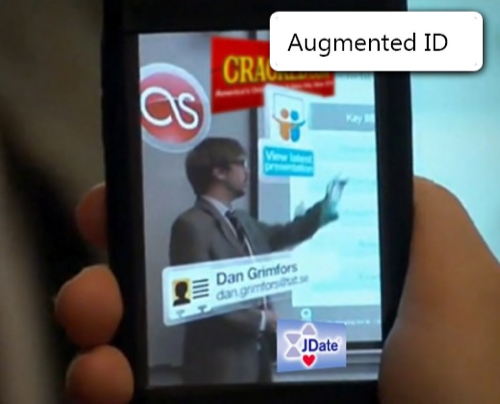Swedish software and design company The Astonishing Tribe, also known as TAT, has been developing a rather astonishing augmented reality application for mobile phones. Originally built as a software concept, the Android app called “Recongnizr” is a mobile prototype that allows you to use your phone in order to “see” who a person is and what web services and social networks they’re connected to. App users can also associate traditional address book details with their profile like their full name, address, phone number and email, for example. And all of this data can be accessed just by aiming your mobile phone at someone’s face.

We first looked at TAT’s mobile concept back in July of last year. At that time, the application was called “Augmented ID.” Using facial recognition and tracking technology from Polar Rose, a photo tagging startup, the app is able to match 3D models of faces captured with the phone’s camera to those stored in a database on remote servers. This matching technique, which captures the shape of the face and other distinctive features like the contour of the eyes, the nose, and the chin, is one of the three methodologies for performing facial recognition. It’s ideal for mobile interfaces such as those found in Augmented ID/Recognizr because it’s not one that’s affected by low-lighting scenarios, a very real possibility for mobile interfaces such as this.
Improvements to the App
Since our last look at Augmented ID, it’s clear that the company has been making great strides in the development of this mobile application. Most notably, the interface’s design has been greatly improved. It now has a much cleaner layout and looks to be far easier to use. The social networking icons, for example, now appear big and bubbly, casually overlaid on top of each other in a row at the bottom of the screen, ready for dragging upward when you go to create your own profile. The same icons, all evenly sized, also float around people’s heads after the app recognizes them. You can then tap the icons to see the profile information they contain. For example, a Twitter icon could showcase the user’s latest tweets when tapped.


The recognition process, too, seems improved. A square shown by a broken line appears on your mobile’s screen around the face you’re trying to recognize. This closely resembles the autofocus systems found on most digital cameras today. When the app “sees” the face, the square’s outline turns from grey to green and the social networking icons zoom in from all sides to float around that person’s face.
The only downside to Recognizr (besides the fact that the prototype isn’t available for use today!) is that it requires both participants to use the mobile application in order to work. That makes the app far less creepy than some all-knowing “Minority Report”-like technology, but severely limits its potential at the same time. Since the prototype is currently Android-only, too, the database of users available for facial matching would only include those who have installed the application on their Android phone and have taken the time to set up their own profile.
That’s not to say that some future version of the application couldn’t scour the web for faces to match – implementing this feature would be challenging, but not entirely impossible. There are plenty of photos on social networks to pull from in the case that a particular person wasn’t already a Recognizr user. However, whether or not the company plans to develop their app to that point is unknown at this time.
Coming Soon to Android
After demonstrating Recognizr at the recent Mobile World Congress, Dan Gärdenfors, head of user experience research at TAT, announced that his company plans to partner with someone who can help bring the mobile concept app to market. He anticipates having a commercial application available in a little as a month or two.
You can watch video demos of both Augmented ID and Recognizr on YouTube, here and here.




















